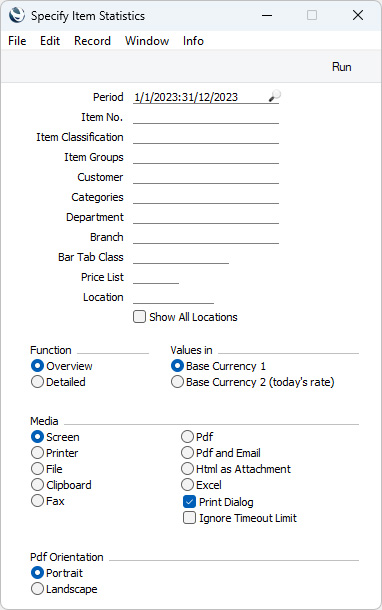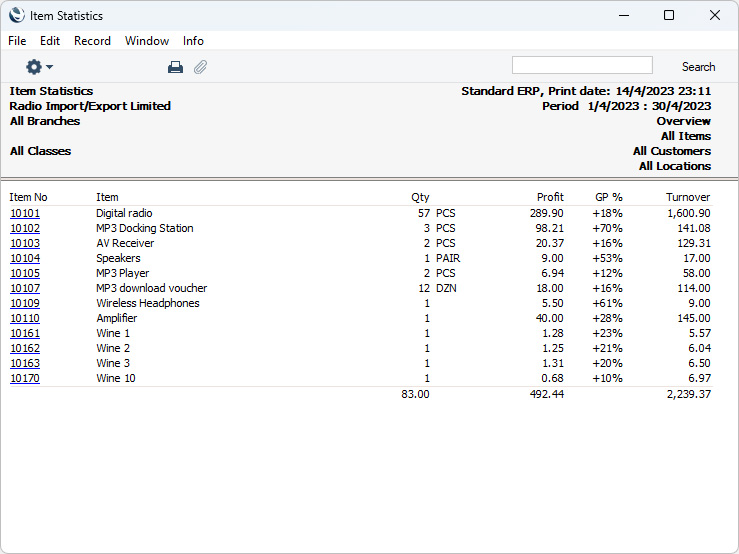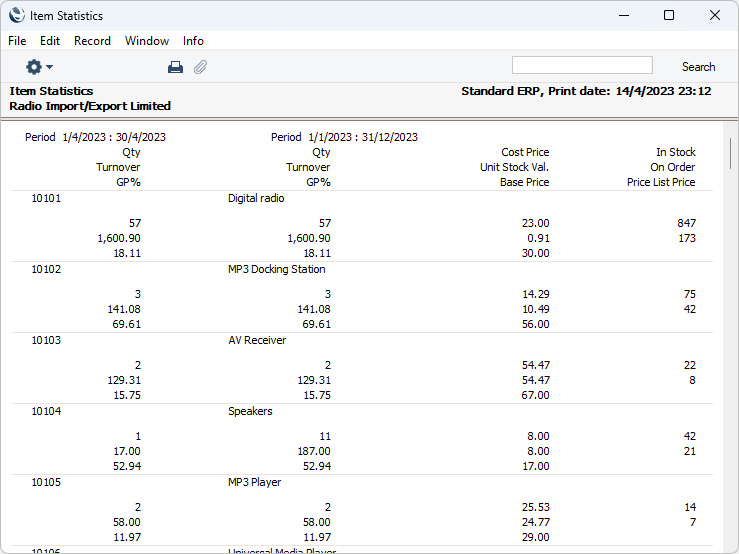Item Statistics
This page describes the Item Statistics report in the Sales Ledger.
---
The Item Statistics report in the Sales Ledger is a list of the Items you have sold during the report period (i.e. the Items included in Invoices, POS Invoices and Bar Tabs from that period). This list displays sales statistics from that period for each Item, including quantity sold, gross profit and margin and turnover (i.e. total sales value).
When printed to screen, the Item Statistics report has the Standard ERP Drill-down feature. Click (Windows/macOS) or tap (iOS/Android) on any Item Number to open the corresponding Item record.
An alternative method that you can use to produce an Item Statistics report for an individual Customer is to produce a Customer Statistics report and drill down from a Customer Number in that report.

Leave all the fields blank if the report is to cover all the Items in the Item register. If you need to restrict the coverage of the report, use the fields as described below.
- Period
- Paste Special
Reporting Periods setting, System module
- Enter the start and end date of the reporting period. The sales statistics in the report will be compiled from Invoices, POS Invoices and Bar Tabs recorded during the period that you specify here.
- Item No.
- Paste Special
Item register
- Range Reporting Alpha
- If you need the report to show sales statistics for a particular Item, enter its Item Number here. You can also enter a range of Item Numbers separated by a colon (:).
- Item Classification
- Paste Special
Item Classifications setting, Sales Ledger
- Enter an Item Classification here if you need the report to list statistics for Items with a particular Classification. You can enter a number of Classifications separated by commas, in which case only Items featuring all the Classifications listed will be shown in the report. If you enter a number of Classifications separated by plus signs (+), Items featuring at least one of the Classifications listed will be included in the report. If you enter a Classification preceded by an exclamation mark (!), all Items featuring any Classification except the one listed will be included.
- For example:
- 1,2
- Lists Items with Classifications 1 and 2 (including Items with Classifications 1, 2 and 3).
- 1+2
- Lists Items with Classifications 1 or 2.
- !2
- Lists all Items except those with Classification 2.
- 1,!2
- Lists Items with Classification 1 but excludes those with Classification 2 (i.e. Items with Classifications 1 and 2 are not shown). Note the comma before the exclamation mark in this example.
- !1,!2
- Lists all Items except those with Classification 1 or 2 or both. Again, note the comma.
- !(1,2)
- Lists all Items except those with Classifications 1 and 2 (Items with Classifications 1, 2 and 3 will not be listed).
- !1+2
- Lists Items without Classification 1 and those with Classification 2 (Items with Classifications 1 and 2 will be listed).
- (1,2)+(3,4)
- Lists Items with Classifications 1 and 2, and those with Classifications 3 and 4.
- 1*
- Lists Items with Classifications beginning with 1 (e.g. 1, 10, 100).
- 1*,!1
- Lists Items with Classifications beginning with 1 but not 1 itself.
- *1
- Lists Items with Classifications ending with 1 (e.g. 1, 01, 001).
- 1*,*1
- Lists Items with Classifications beginning and ending with 1.
- Item Groups
- Paste Special
Item Group register, Sales Ledger
- Range Reporting Alpha
- If you need the report to list statistics for the Items that belong to a particular Item Group, specify that Item Group here.
- If you specify both a range of Items and a range of Item Groups, the report will only list the Items in the range that are members of the specified Item Groups.
- Customer
- Paste Special
Customers in Customer register
- If you need the report to list the Items you have sold to a particular Customer, enter the Contact Number for that Customer here.
- Categories
- Paste Special
Customer Categories setting, Sales Ledger
- Range Reporting Alpha
- If you need the report list the Items you have sold to Customers belonging to a particular Customer Category, specify that Category here. You can also enter a range of Categories separated by a colon (:), in which case the report will include separate sections for each Category.
- Department
- Paste Special
Departments setting, Assets module/System module
- To list Items belonging to a particular Department in the report, enter that Department here. The Department of an Item is taken from the 'Stock' card of the Item window.
- Branch
- Paste Special
Customers in Contact register
Specify a Branch if you only want the statistics in the report to be compiled from Invoices, POS Invoices and Bar Tabs featuring that Branch. This will be useful if your company has several Branches (e.g. several shops): the Branch where each transaction was created will automatically be recorded (for example, on the 'Del. Terms' card of the Invoice window), taken from the Local Machine setting in the User Settings module.
- Bar Tab Class
- Paste Special
Bar Tab Classes setting, Restaurant module
- Specify a Bar Tab Class if you only want the statistics in the report to be compiled from Bar Tabs featuring that Class. If you specify a Bar Tab Class in the Local Machine setting in the User Settings module on a particular computer or till, it will be copied to all Bar Tabs created on that machine. If you want waiters to be able to change the Class in a particular Bar Tab, add a "Set Tab Class" button to the Bar Tab window.
- Price List
- Paste Special
Price List register, Pricing module
- This field is only used by the Detailed version of the report, which prints the Base and Cost Prices of each Item. If you specify a Price List here, the Price according to that Price List will be shown as well.
- Location
- Paste Special
Locations setting, Stock module
- Range Reporting Alpha
- Specify a Location if you only want the statistics in the report to be compiled from Invoices, POS Invoices and Bar Tabs issued from that Location. You can also enter a range of Locations separated by a colon (:).
- Show All Locations
- If you have not specified a Location or have specified a range of Locations in the field above, the report will display total figures for sales made from all Locations or from all Locations in the range. Select this option if you would like individual sales figures for each Location to be displayed as well.
- For example, if you have sold three units of an Item from Location 1 and four from Location 2 during the report period, the default version of the report will show that you have sold seven units. If you select this option, the report will show that you have sold seven units, and on the following lines it will show the three and four units that you have sold from each Location. If you have a Location 3 that did not sell any units, that Location will not be listed.
- Function
- Select one of these options to specify the level of detail that you need to be included in the report.
- Overview
- This option offers a single line per Item showing the quantity sold, the gross margin and profit and the turnover during the report period.

- Detailed
- This option compares the quantity sold, gross profit and turnover of each Item during the report period with the same figures for the current Fiscal Year. This option also shows for each Item its Cost and Base Prices (from the Item record), its unit stock value (calculated using the usual Cost Model) and the quantities in stock and on order. Finally, if you have specified a Price List in the field above, the Price according to that Price List is shown as well.

- Values in
- If you are using the Dual-Base system, use these options to specify whether the values in the report are to be shown in Base Currency 1 or 2.
- If you are not using the Dual-Base system, use the Base Currency 1 option to produce a report in your home Currency.
---
Go back to:
|
